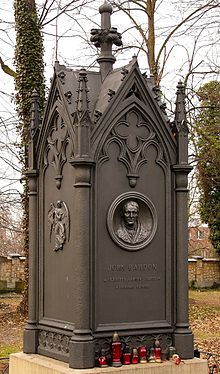John Baildon

John Baildon (born December 11, 1772 in Larbert , Stirlingshire , Scotland , † August 7, 1846 in Gleiwitz , Upper Silesia ) was a Scottish-German civil engineer and designer .
Life and work
John Baildon studied mechanics , hydraulics and technical drawing under Daniel Manson in Stirling . In 1789 he met the Prussian Mining Commissioner Friedrich Wilhelm von Reden from Upper Silesia . With the support of John Smeaton , one of the greatest engineers of the time, he was given the position of technical consultant at the age of 21 and was involved in the construction of the Royal Prussian iron foundry in Gleiwitz . Baildon's job was to design the coke furnace for smelting the iron ore and to supervise its commissioning .
After commissioning on September 10, 1796, the first (historical) pig iron flowed out of the blast furnace . His blast furnace was the first of its kind on mainland Europe. These steel works in Domb near Katowice were named after him Baildonhütte . It was a puddling plant with four puddling ovens. A street near the Baildonhütte was named after him Baildonstrasse (ulica Johna Baildona).
According to his construction plans, the Klodnitz Canal with a length of 46 km was created in the years 1792–1812 .
He was also involved in the construction and casting of the components of the oldest iron arch bridge on the European mainland over the Striegauer Wasser near Laasan , Schweidnitz district , Lower Silesia . It was the first cast iron bridge in Germany. The five arches were cast in the ironworks in Malapane in 1794–1795 and erected on July 30, 1796. This cast iron bridge with a span of 12.5 meters lasted for over 148 years and was blown up in the spring of 1945.
In 1799, Baildon and Johann Friedrich Wedding designed the construction plans and cost estimates for the Königshütte in Königshütte , which was the most important ironworks in Europe at the time. Bailton made the drawings for the first steam- blower machines in this hut , just as he designed the machine tools for the royal ironworks in Gleiwitz, and built the first two coke ovens there from 1800–1802 . On September 25, 1802, the first of the coke ovens, the largest blast furnace on the continent, was blown. In honor of the founder of the company Friedrich Wilhelm von Reden, it was called Redenofen .
He was also the designer of the first industrial steam engine in Germany. The machine parts were cast in the royal hut in Gleiwitz. This steam engine was in operation at the Königliche Porzellan-Manufaktur Berlin (KPM) from 1800 to 1824, i.e. around 25 years .
John Baildon married Helene Galli in 1804, settled in Gleiwitz and lived there until the end of his life. The cast iron grave is located in the Gliwice Hüttenfriedhof and was reconstructed in 2012 . His son Arthur Adam John Baildon (1822-1909) was ennobled as " by Baildon and Briestwell " in 1881.
literature
- Baildon, John, entrepreneur . In: Walther Killy , Rudolf Vierhaus (Hrsg.): Deutsche Biographische Enzyklopädie (DBE) . 1st edition. tape 13 : Supplement . KG Saur, Munich 2003, ISBN 3-598-23173-3 , p. 21 .
- Herbert Dienwiebel: Baildon, John. In: New German Biography (NDB). Volume 1, Duncker & Humblot, Berlin 1953, ISBN 3-428-00182-6 , p. 544 f. ( Digitized version ).
Web links
- Literature by and about John Baildon in the catalog of the German National Library
- freewebs.com
| personal data | |
|---|---|
| SURNAME | Baildon, John |
| BRIEF DESCRIPTION | German civil engineer and designer |
| DATE OF BIRTH | December 11, 1772 |
| PLACE OF BIRTH | Larbert , Stirlingshire , Scotland |
| DATE OF DEATH | August 7, 1846 |
| Place of death | Gleiwitz , Upper Silesia |

